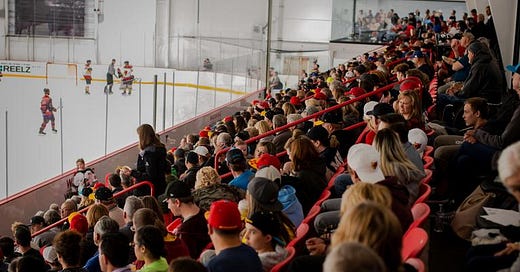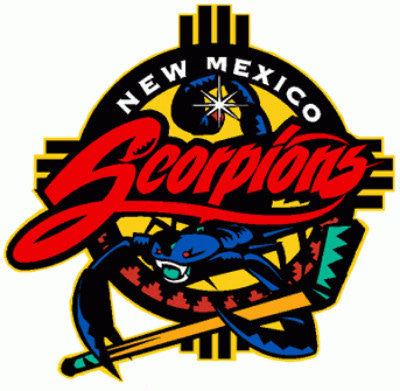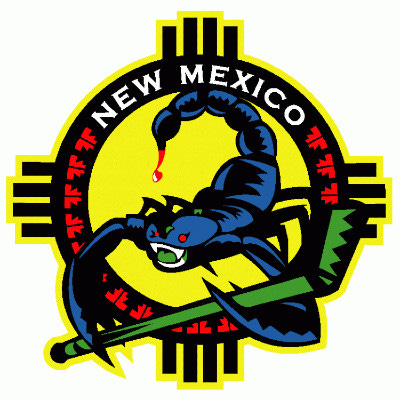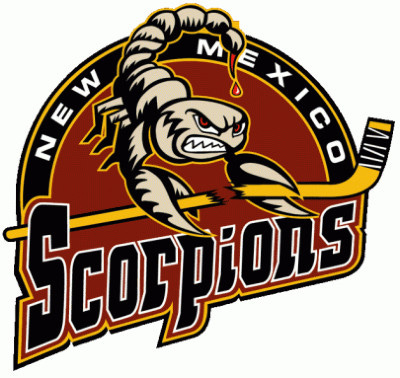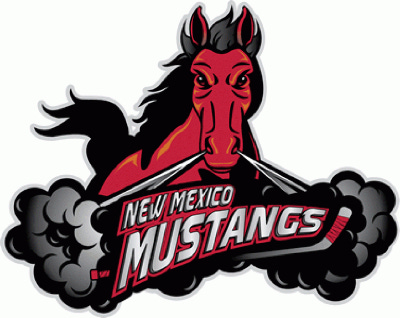Hockey History: Albuquerque, NM
The Duke City has long but intermittent history in the Coolest Game on Earth.
Albuquerque, NM is not a city most people, let alone most hockey fans, would think of as a hockey crazed city. But the Duke City’s history in the sport dates back to early 1970’s and the original version of the Central Hockey League and all the way up to the present day with the NAHL’s New Mexico Ice Wolves. From Six-Guns to Scorpions to Ice Wolves this is the hockey history of Albuquerque, New Mexico.
Nothing better than a good ole’ six-shooter:

Prior to the 73-74 season the Central Hockey League expanded from four teams to six clubs. Those two expansion spots went to Oklahoma City, OK, the Blazers (Toronto Maple Leafs), and Albuquerque, NM.
The new club would be named the Six-Guns and make their home out of the then 20 year old, 9,286 seat Tingley Coliseum on the grounds of Expo New Mexico. The WPA project coliseum took over two decades to build and was originally built, like most fairgrounds arenas, to hold rodeo’s and horse shows. The Six-Guns themselves we’re staged to be an affiliate of the Kansas City Scouts, however the Scouts would not enter the NHL until 1974-75, thus requiring the Six-Guns to go independent. After a single season in the CHL, finishing in sixth place out of six with a record 16-40-16, totaling 48 points the club withdrew from the league and folded after their lone season.
Here come the Chaparrals:
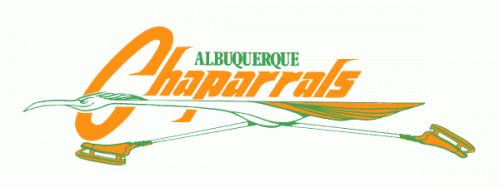
The following season former North Dakota Fighting Sioux goalie, Ralph Engelstad, established the Southwest Hockey League. The SWHL was founded as a league to develop players for the collegiate and professional game. Similar to junior hockey, the owners would pay for their players room and board, as well as tuition for a local college. Since they we’re “technically” amateurs they did not draw a salary but we’re provided a $60/week stipend similar to Major Junior hockey players. The league functioned more as a Senior-Amateur league as there was no official age cap.
Six cities, Albuquerque, New Mexico; Amarillo, Texas; Billings, Montana; Butte, Montana; El Paso, Texas; and Reno, Nevada we’re awarded franchises for the leagues first season. The new Chaparrals would take to the ice at the 20+ year old Tingley Coliseum, just like the Six-Guns did. Unlike their CHL predecessor, the Chaparrals we’re one of the best teams in the SWHL. In 1975-76 they finished 39-32-1 with 79 points, losing out on the SWHL Championship by just three points to the Amarillo Wranglers.
The SWHL’s second campaign didn’t go as planned however. The league would end up playing just until January before deciding to fold up shop. The Chaparrals faced their own problems in that time period too. After a failed promotion in December of 1976 saw none of the proceeds go towards the players, Head Coach Bob Gernander and 12 players left the club in protest. Albuquerque came back with Cal Swenson as bench manager, but the league folded less than a month later. In 1976-77 the Chaparrals finished in 5th place (of 6) with an 18-25-0 record and just 36 points.
Feel the Sting, the Scorpions arrive:
It would then take nearly two decades for high level hockey to return Land of Enchantment’s capital. The New Mexico Scorpions joined the Western Professional Hockey League ahead of the league’s 1996-97 campaign. Using the unique blend of colours, animals, and design that only New Mexico has the Scorpions came out with an instantly recognisable logo (seen above) and jersey. The Scorpions would join a league consisting of Amarillo, TX (Rattlers); Austin, TX (Ice Bats); Belton, TX (Central Texas Stampede); El Paso, TX (Buzzards); and Waco, TX (Wizards).
The low-level league was popular in every market it played in and the Duke City was no exception. The expansion Scorpions drew an average of 5,418 fans per game to the now 40+ year old Tingley Coliseum, a number only bested by the Austin Ice Bats 6,239. As good as they we’re in the stands they we’re even better on the ice. The Scorpions led the league in penalty minutes (2,710), goals for (323), and points (86); with head coach Taylor Hall leading them to a 42-20-2 record giving them their first regular season Governor's Cup title.
New Mexico also had the leagues top two scorers in Sylvain Naud and Kurt Wickenheiser who combined for 93 goals. Jody Praznik, Mike Tomlinson, and Sylvain Naud all finished in the Top 10 in assists with Naud, Tomlinson, and Wickenheiser also finishing in the Top 10 in points. Tyler Boucher and Dean Shmyr combined for 503 penalty minutes to also finish in the league’s Top 10. After an impressive regular season and with fantastic individual performances the playoffs wouldn’t be so kind as New Mexico was dropped 4 games to 2 by the #4 seed Central Texas Stampede in the Semi-Finals.
The team returned for the 1997-98 season, with former Tulsa Oilers (CHL) bench boss Garry Unger taking over for Taylor Hall, and finishing tied for third in points (91) in a heavily expanded WPHL, one that doubled from six teams to 12 in the offseason. The Scorpions fortunes would stay the same in the playoffs, this time being bounced in the Semi-Finals by eventual champion El Paso 4-3.
At the same time as the Scorpions we’re finding their stride the city also got it’s first taste in junior hockey. This came in the form of the New Mexico Ice Breakers in the Tier III Western States Hockey League. The Ice Breakers would play out of the Outpost Ice Arenas on the outskirts of the city and only lasted two seasons; going 32-5-1 with 65 points their first. They would go 28-14-1 their second season, missing the playoffs before folding.
With the Scorpions heading into the 1998-99 season things looked to be on the up and up. The WPHL expanded to 17 teams, the club returned head coach Gary Unger, had made the playoffs both seasons, and finished no lower than tied for third their first two years. However things bottomed out in 98-99, after just 51 games Unger was ousted as head coach and replaced by skating coach Mark Ciaccio for the last 18 games of the season. New Mexico finished 27-34-8 with 62 points, ending in sixth place (of 6) in the Western Division and 15th (of 17) in the WPHL.
After bottoming out in 98-99 former Scorpion player Tony Martino took over the Scorpions for 99-00 as head coach. he WPHL also expanded to 18 teams but didn’t finish with the same number as Waco and Abilene folded after 27 and 26 games respectively. New Mexico rebounded off their worst season to this point extremely well going 49-18-3, good enough for second place in the league with 101 points and the Western Division title. After a first round bye Martino’s team took down the Corpus Christi IceRays 3 games to 1 in the second round before beating Austin 4 games to 1 to advance to the WPHL President's Cup Finals. After taking a 2 games to 1 lead over the Shreveport Mudbugs won 3 straight games to defeat the Scorpions 4-2 in the Scorpions only WPHL President's Cup Finals appearance.
2000-01 would be the WPHL’s final season as a league by itself (more on that later) and it saw a contraction from the 16 teams who finished the 99-00 season to just 14 teams. After a President's Cup Final appearance the year before the Scorpions had the championship appearance hangover going 44-23-4 with 58 points, finishing 6th (of 7) in the division, 12th (of 14) in the league, and missing the playoffs for only the second time.
Baptism by Fire, Welcome to the CHL:
Following the 2000-01 season the Western Professional Hockey League and Central Hockey League merged to form the “new” Central Hockey League for the 2001-02 season. Between the two leagues they had a combined 26 teams in 2000-01, the newly merged league would begin play with just 16 in 2001-02. One team (Border City) in the CHL folded mid-season the year before while five more would leave the league, fold, or be replaced altogether by another team from another league. In their place would be 10 of the 14 teams who made up the previous WPHL season. Central Texas had folded during the previous WPHL season, while Lake Charles, Monroe, and Tupelo all folded during the merger.
While the CHL kept the name and branding of the older of the two leagues, make no doubt this was more or less an expanded WPHL with one caveat, the CHL was going to dominate the merged league. In the following 13 seasons only twice did a former WPHL team win the Ray Miron President's Cup. New Mexico was no exception to the struggle going 33-25-6 with 70 points, finishing last in the four team Southwest Division.
Following a lacktustre CHL debut Tony Martino would resign as head coach and head to Tennessee to coach the ACHL’s Knoxville Ice Bears for 2002-03. Another former Scorpion, this time Pat Dunn, would be promoted and replace Martino as bench boss. In December, Dunn would move to become the new VP/GM of the Corpus Christi IceRays and Bill McDonald went from Lubbock, TX to Albuquerque to coach the Scorpions. McDonald brought the Scorpions to a final record of 31-28-2-3, finishing second in the division and getting into the CHL Playoffs. However the Ice Bats dropped New Mexico 3 games to 1 in the opening round.
McDonald would continue to coach the Scorpions as they headed into the 2003-04 season. New Mexico for the second time in three CHL seasons would miss the playoffs after finishing 32-27-2-3 with 69 points. Mike Oliveira would finish in the Top 10 in the league in both goals and points, the first Scorpion player to do that since the WPHL-CHL merger. In 2004-05 head coach McDonald would return for his third season behind the bench for New Mexico. With the CHL expanding to 17 teams, New Mexico was moved to the Northwest Division. Even with the division change the Scorpions missed the playoffs once again with a 27-27-1-5 record sat them in third (of 5) in the Northern Conference’s Northwest Division. Randy Murphy would just barely crack the league’s Top 10 in goals scored in a fairly uneventful season for the Scorpions.
Following the end of the 04-05 season Bill McDonald would step down as head coach towards the beginning of April. Less than one month later owner Doug Frank announced the team would not play in 2005-06 and rather would wait until the 2006-07 season to play again. Owner Doug Frank would say in interviews that Expo New Mexico was not going to guarantee certain scheduling dates for the Scorpions, but rather provide them to the expansion NBDL team.
"The conditions in the building and outside the state fairgrounds and the people that run the state fairgrounds make it absolutely untenable and impossible for us to go forward," said owner Doug Frank.
The club would now focus on 2006-07 and moving into a new arena being built on the outskirts of the City of Rio Rancho. While the Coliseum was old, the fanbase was strong and the Scorpions had never averaged less than 4,000 fans per game during their tenure at the Coliseum. Days after the announcement that the Scorpions would not play in 2005-06, owner Doug Frank announced former San Angelo Saints head coach Ray Edwards would take over the duties for New Mexico. In January 2006, Scorpions Hockey Club LLC headed by Dave Ellett would purchase the team from Doug Frank.
Out to the Suburbs:
With new ownership and a new home New Mexico Scorpions would come back for the 2006-07 season in the brand new Santa Ana Star Center in Rio Rancho, a northwest Albuquerque suburb, as well as undergoing a heavy rebrand for their return. Ditching their colourful Southwestern aesthetic in favour of a maroon, gold, black, and tan colour scheme with an even more anthropomorphic scorpion.
Ray Edwards would lead the team for their return to the Central Hockey League. New Mexico would come back to their best season ever in the CHL going 32-24-3-5 with 72 points, winning the Southwest Division. The Scorpions take down the Amarillo Gorrillas in the opening round 4 games to 2 before beating the Arizona Sundogs 4 games to 3 to advance to the Southern Conference finals. The Laredo Bucks would easily defeat the Scorpions 4 games to 1 to win the Southern Conference championship.
With Edwards leaving for the AHL’s San Antonio Rampage, former player Randy Murphy would take over coaching duties for the remainder of the Scorpions tenure in the CHL. Murphy would coach New Mexico to a respectable 34-24-4-2 record for second place in the Southwest Division. Konrad Reeder would finish in the league’s Top 10 in Goals, Assists, and points, while Kevin Harvey would finish in the Top 10 in penalty minutes. New Mexico would gain a bye into the Conference Semi-Finals but we’re trounced four games to two by the Arizona Sundogs and eliminated from the playoffs.
2008-09 would be both good and bad on the ice for New Mexico. Craig Macdonald and Chris Robertson would both finish in the Top 10 in goals with Robertson also finishing in the Top 10 in total points. The Scorpions would miss the playoffs going 27-33-3-1 with 58 points. Off the ice the season was even more tumultuous. By December the team was reportedly facing financial trouble and the league gave the ownership group an initial May, eventually extended to June 15th then extended again to an indefinite deadline to sell the team. However on July 6th the sword finally fell and the Scorpions officially folded.
Since moving to Rio Rancho attendance had flatlined. Over nine years in Albuquerque at the Coliseum the Scorpions averaged 4,602 fans per game and never sank lower than 4,026. In their final season before moving to Rio Rancho they had an average of 4,554, while after moving to Rio Rancho it was 3,217. It then sank to 2,979 before dropping to an average of 2,791 in their final season.
While a sparkling brand new arena, built with a traditional Southwestern architecture exterior, looked to be great for the team; the building itself had one major downside, the distance to get there. It was not put in a good spot for a majority of the Albuquerque Metro Area. The arena was built as part of Rio Rancho’s City Center complex, a complex conceived to be built up around a new City Hall and the arena for an urban sprawl that still to this day hasn’t come.
The now renamed Rio Rancho Event Center is 26.1 miles northwest of the Coliseum bringing it to 35+ minutes of driving to get there. That distance only gets longer as you go further south and or east where a majority of the population is. Those factors amongst many others led to a huge and unsustainable decline in attendance for the Scorpions, sadly helping end their existence and the existence of pro hockey in New Mexico.
Junior Hockey Returns:
The end of the Scorpions would not be the end of all hockey in the state or the area. After the 2008-09 season the Western States Hockey League’s Texas Renegades moved from Fort Worth, TX to Rio Rancho, NM. The newly renamed New Mexico Renegades would make their home at the Blades Multiplex Arena (now the McDermott Athletic Center).
The Renegades first season in New Mexico was not a good one as they finished last in the five team Mid-West Division with a record of 8-43-1 ganering just 17 points. The following year would see little improvement with the Renegades going 8-35-3, good for 19 points along with finishing last in the division and league. The WSHL would heavily expand for the 2011-12 season, the club’s third, and that proved to be the one of only two respectable seasons they would have. The Renegades managed to go 18-26-2 with 38 points, still not even enough to challenge for a top spot in the division.
2012-13 would see the WSHL expand even more and the Renegades finish 19-26-1 with 39 points. This was just barely better than their 11-12 performance and would be the best performance they would have in their five year existance. In 2013-14 the Renegades would manage a record of just 5-40-1, good enough for only 11 points in their fifth season. However, shortly after the season ended in April owners Joe MacConnell and Ken Tomaro relocated the team to Springfield, MO as the Express to play out of the Mediacom Ice Park until folding following the 2017-18 season.
Enter the North American Hockey League:
After a single season without high-level hockey, the Tier II Junior A North American Hockey League would enter the market. The NAHL was not entirely unfamiliar with New Mexico as the Santa Fe Roadrunners had played out of the state’s capital from 2004-07 before moving to Topeka, KS.
While the WSHL’s New Mexico Renegades had already taken a spot, the NAHL was in a completely different category when it came to junior hockey. The NAHL supplies players with equipment, ice time, travel, and more, with the players typically only paying a billet fee to the family housing them, along with any personal expenses. Whereas for Tier III leagues (of which the WSHL is one of) players and or their parents will typically pay for everything, including fees for playing on the team.
In March of 2010 the NAHL officially approved and granted expansion status to the New Mexico Mustangs, who would make their home out of the now vacant Santa Ana Star Center beginning that fall. The new team would be owned by Ken Dennis and coached by former NHLer Bill Muckalt. Similar to the Renegades, but not as bad, the Mustangs would struggle through their first season the club finished 19-35-1-3 with only 42 points, last in the South Division. Off the ice things weren’t too hot either as they finished 16th of 26th in attendance averaging 802 fans per night.
At the end of the first season head coach Bill Muckalt would leave the club to take an assistant coaching position at Michigan Tech University in WCHA. Replacing Muckalt would be Jason Kersner for the team’s 2011-12 season. With over half the roster being 18 or under their first season, the team would be looking for some progress on and off the ice. However, neither of those happened as the Mustangs finished 18-39-1-2 with 39 points and dropped to an average of 722 fans in attendance.
In late May, a few weeks following the Robertson Cup Championship, the Mustangs we’re granted “inactive status” for the 2012-13 NAHL season. That December, the club and it’s membership we’re acquired by the Minnesota Junior Hockey Group and relocated to the 1,800 seat Richfield Ice Arena as the Minnesota Magicians, where they remain to this day.
The North American Hockey League Returns:
After 7 years without high-level hockey in the area and 14 years without it in Albuquerque proper, on February 28th, 2019 the NAHL announced that Desert Ice Investment, LLC, had been granted an expansion franchise in the league. Owner Stan E. Hubbard, who had recently bought the Outpost Ice Arenas, also would heavily renovate the building ahead of the Ice Wolves first season. Stillwater, MN native and rormer NAHL, USHL, and pro hockey player Phil Fox was named as head coach for the team’s first season in 2019-20. Their first season saw an average attendance of 1,126, in an arena that seats only 1,000 in their main rink. On the ice the Wolves went 13-34-2-3 in the COVID-19 shortened NAHL season.
Phil Fox and the Ice Wolves returned for another COVID-19 shortened in which due to state regulations they played away from home and with closed doors or limited attendance for a majority of the season. The Ice Wolves finished 21-30-3-2, but missed the playoffs by 20 points as they finished fifth in the six team South Division. As of the beginning of the 2021-22 season, Phil Fox is still the team’s head coach and they are having an average of over 1,000 fans attend their games at the Outpost Ice Arenas.

